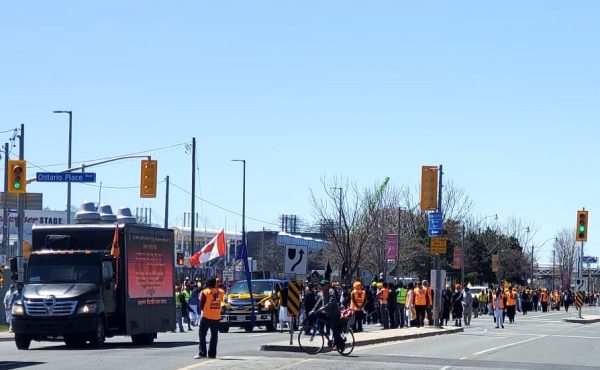
Having worked with the Beautiful City alliance to win the billboard tax and signs by-law [PDF] that was adopted by City Council yesterday, I’ve got a few stories from that experience that I want to share with Spacing readers in the coming days.
To contextualize my vantage point in this process, I worked to bridge the interests of the artists and public space activists within the Beautiful City alliance, which included a variety of arts and public space advocates, as well as allies in the community and small business sectors (including Spacing). I also steered communication and the political-level work. My efforts would have meant nothing without the capability of the arts community to mobilize thousands of people and the public space activists’ capacity to understand and manipulate the sign-related legal framework the City operates within. Though I suppose it’s easy to say now, even if the vote hadn’t gone our way yesterday, I would have been much better off for having had the opportunity to work with so many talented and passionate activists.
Going through the campaign chronologically is probably best left to Devon Ostrom’s inevitable doctoral thesis (disclaimer: some history is necessary for this article) so I wanted to start with something a bit more topical given today’s coverage of yesterday’s decision: the issues surrounding arts funding.
The arts funding component of the Beautiful City campaign, while consistently popular [PDF] in the public opinion polls we commissioned, took a bit of a beating on the blogs and was used as a wedge by a few city councillors (the same few that don’t see the merit in arts funding generally). Though you can be sure that Beautiful City will assert its voice during the operating budget process when it kicks off early next year, I’m not going to make the pitch here for the money; you can see that in the background information provided at BeautifulCity.ca. Instead, I’ll tell the story of why and how the arts piece made it into the recommendations City staff made to Council and what was in fact recommended to Council, what Council’s decision means and where it leaves the arts funding issue going forward.
Beautiful City spent about four years trying to get the City’s bureaucracy to listen to its idea of a billboard tax for art. The bureaucracy, like me when I first heard the idea as a member of the Toronto Youth Cabinet, basically said, “Nice idea but Toronto doesn’t have the power to tax billboards†(though unlike the bureaucrats, the Youth Cabinet endorsed the campaign anyways). Then came the City of Toronto Act and the consultations on “revenue tools†that accompanied it. Beautiful City’s idea of a billboard tax for art was finally possible and so the campaign promoted its idea at every consultation. In the end, the consultant’s report on new taxes (known as the Hemson Report) reported that a billboard tax was the most popular tax at the consultations. But the City didn’t have the capacity to work on the billboard tax as well as the land transfer tax and personal vehicle tax, both of which would see greater revenues than a billboard tax and, because of the provincial infrastructure in place, be easier to implement. Plus, there was an emerging campaign from the public space activists on illegal billboards and City staff figured (to their credit) that any billboard tax should be designed at the same time as sign laws were being reformed. This concept — linking a billboard tax for enforcement of the signs by-law as well as art and public realm improvements to a sign by-law reform initiative — was recommended by staff [PDF] at Executive Committee and endorsed by Council as part of the package of taxes it did decide to pursue in 2007. The impetus for recommending the money be linked to enforcement, art and public realm spending was the result of positive comments for those uses (including the billboard industry’s support for spending on enforcement) and the direction that new taxes be used to accomplish specific public policy objectives.
Though ultimately City Council decided against linking any one tax to any one policy objective dollar-for-dollar, since staff had been directed to think in those terms, that’s what staff brought forward in their tax reports. And thus the institutionalization of the billboard tax for art recommendation, and a separate recommendation for enforcement of the sign by-law.
While a tax without such strong-willed proponents may have seen the art allocation recommendation fall by the wayside (enforcement is a common allocation from a user fee so that allocation was not controversial), staff could not unilaterally make this one fade so easily. Instead, staff intentionally used fuzzy wording [PDF] — the language used was “offset†arts and public realm funding — that would meet their obligation to bring forward a recommendation for arts funding but not actually bind Budget Committee’s hands in their 2010 budget deliberations. If one thing was for certain, there was no guarantee in that recommendation that arts funding would receive even the same amount of money as it had the year before.
On the one hand the “offset†wording was smart but on the other hand no one really knew what it meant. Though councillors not knowing what they’re voting for hasn’t always been a barrier to adopting a given recommendation, this issue was scrutinized to the point that such wording just didn’t cut it. Some councillors were concerned about it to the point that, almost as punishment for their confusion or unease, they would only support the recommendation with the lower $6.1 million tax level proposed by Councillor Norm Kelly. In a bid to fight off the 40% cut in revenue, the arts community proposed [see #18] to Councillor Shelley Carroll that the offending recommendation be replaced with one that would see the money go to her Budget Committee with clear wording to allow Budget Committee to allocate the funds as it sees fit. Nothing changed in terms of actual money dedicated to the arts and public realm but this made it possible for Council to support the $10.4 million tax because they knew what they were voting for.
Though the motives were different, right-wing Councillor Case Ootes was conveniently planning to move the same motion that we proposed so when Councillor Carroll moved it, she moved it on Ootes’s behalf (he was absent at the time), which brought a greater amount of consensus to the issue. In fact, it’s likely what cemented our swing votes on this issue as councillors Ashton, Hall, Jenkins, Mammoliti, Moeser and Palacio voted for the $10.4 million tax. [Click here for all recorded votes. The vote on the $10.4 million option is titled “Recommendation 4 of the Supplementary Staff Report.”]
As an aside: we were hesitant to ask one of our councillor allies to move a more specific motion to dedicate funding to arts for fear of the free-for-all that would likely have broken out. If a debate like that was going to be had, it would have been terribly messy as most councillors would have sought to take some or all of the tax revenue for their own pet project. Moving the debate to budget committee still allows everyone to bid for a piece of the billboard tax pie but the discourse will be in the context of the entire budget and all funding priorities, making it, twisted as it may sound, an easier conversation to have. Further, dedicating the tax to a specific purpose for one year makes it a bit easier to keep the money going to arts in following years but is absolutely no guarantee because, as is a popular phrase around City Hall, council is supreme.
Looking forward to Budget Committee, Beautiful City is as aware as everyone else that the City, in terms of its operating budget, is in deep this year. Though spending is going to be restrained greatly across many parts of the City’s operations, we believe certain priorities, like bringing prosperity to priority neighbourhoods and furthering some of the Clean and Beautiful City programs, will still receive funding. So the intent is to work with Budget Committee and find out where our expectations meet their funding priorities. Given that every single member of Budget Committee has expressed their support for a billboard tax that funds arts and public realm enhancements, we don’t believe our confidence is misplaced.
Photograph by NMinTO.




2 comments
Thanks for this overview of the nuts and bolts of the political process. Many who are unfamiliar with Council and the work needed to pull together votes, and who didn’t sit through the whole process, may be surprised to see what it takes to get concensus on something like this.
I saw this post in Google Reader and was like, damn that picture looks familiar! Thanks for using it!